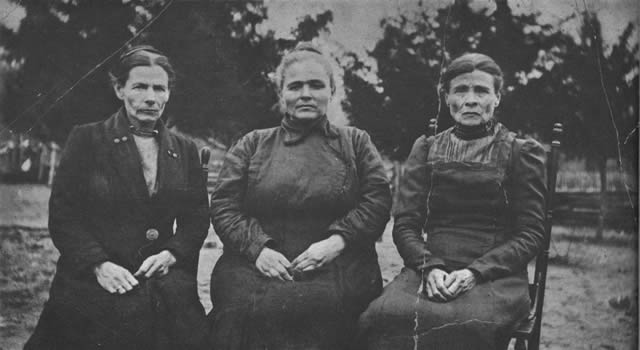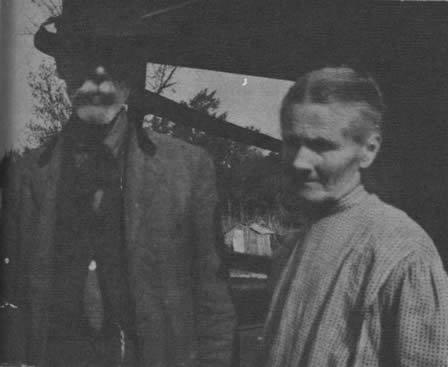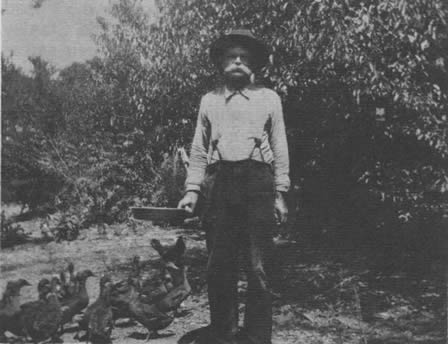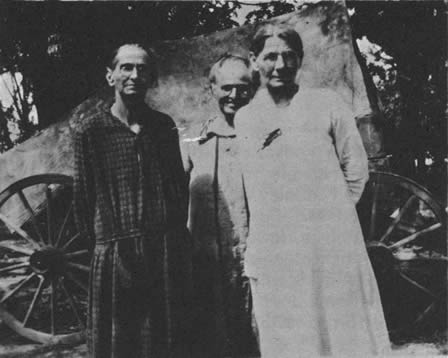Volume 2, Number 8 - Summer 1966
The Stanley Family
Part of our History
By Fauntella J. Hill

My mother, Lydia Hester Stanley Johnson was almost blind for the last ten years of her life. While visiting her I wrote down part of the things she told of pioneer days. The following history is a condensed form of some of the things she told.
My great-grandfather, Elijah Stanley, who was the son of James Stanley and Catherine Hutchens Stanley of Virginia, was born in 1798. He married Rachel , who was born January 18, 1802. She was Pennslyvania Dutch (German) descent. Both belonged to the Quaker Church. They used singular pronouns when speaking to only one person. They lived in a Quaker Forbush in Surry County, North Carolina. They may also have lived near Raleigh and in Guilford County, North Carolina.
About 1851 the Elijah Stanley family came with a large wagon train to Iowa. Then before 1863, they came to Jasper County, Missouri. During the Civil War they lived near Carthage. Valuable possessions and food were kept hidden. Bands of men roamed the area plundering homes.
Rachel Stanley was thrown by her saddle horse during the Civil War. She landed on her head and remained in a coma for weeks afterward. Her son, Enos Stanley, was given furlough from the Union forces to visit his mother. Her doctor hoped the sound of Enos’ voice might rouse
[8]
Rachel. It did not. Finally she regained conscienceness and made complete recovery. She died about 1869. She is buried near Carthage, Missouri.

Elijah Stanley went to Taney County, Missouri shortly after his wife, Rachel’s death. There he lived with his son, Enos, and family. He drove a matched team of bay horses, hitched to a light spring wagon. One of the horses was balky. He was a carpenter, brick mason, and farmer. He generally helped to build the fireplace at houseraisings in the neighborhood. He was described as a patient, soft-spoken man. He read aloud, a few chapters from the Bible, to his family each day. He remained active until his death in the winter of 1883-84. He died at the age of 85 years, 1 month and 7 days. He was buried in Stanley Cemetary. (Name of cemetary changed to Patterson after 1896.)
Elijah and Rachel had nine children. Their eldest son, Hutchens Stanley was born January 18, 1825.
Their second son, John Ellis Stanley, was born August 23, 1827. On October 12, 1854 he married Rebecca Lakey in Yadkin County, North Carolina. They migrated to Arkansas.
Enos Stanley was born December 29, 1828 in North Carolina. He married Mary (Polly) Matilda Lakey who was a sister of Rebecca Lakey. They migrated by wagon train about 1851 to Iowa. Then to Missouri in 1861. Later to Arkansas in 1896.
Vestal Stanley was born January 9, 1831. He married Nancy . They migrated in same wagon train to Iowa. He was said to later have sold his homestead off in lots, as the city of Des Moines, Iowa was being built. He was a farmer and bee keeper. He became wealthy. He is buried near Boone, Iowa. They had no issue, but raised one of his wife’s nephews.
Judith Stanley was born July 23, 1833. She is believed to have married William Adams. They lived at Dennison, Iowa.
Mary Stanley was born June 4, 1835. She married Jeremiah Harrison. They migrated from Iowa to Jasper County, Missouri in 1869. Also lived in Barry County. Last heard from in Kansas. They had two sons, Aquilla and Leeroy Laton. Names of their other children are not known.
Issac Stanley was born July 27, 1837. He migrated to Arkansas. He became lost from his brothers and sisters.
Elizabeth Stanley was born December 10, 1839. She married Mr. Doane. They lived on a farm near Des Moines, Iowa. She had a daughter, Ella. Names of her other children are not known.
Amey Ann Stanley was born April 17, 1884. She is believed to have married William Doane. They lived in town. She had four children, maybe more.
The birth dates of this Stanley family are from records kept by Elijah and Rachel Stanley. He also kept letters written by some of their children. They were written in ink and are still readable.
My grandfather, Enos Stanley, who was born December 29, 1828, grew to manhood and was educated in North Carolina. About 1849 he married Mary (Polly) Matilda Lakey, who was born April 6, 1827. She was called "Polly." Her father, Abram Lakey owned a large cotton plantation. It was located in that part of Surry County, which was reorganized into Yadkin County, North Carolina in 1850. Polly belonged to the Primative Baptist Church. Later Enos changed from the Quaker to the Baptist Church.
Enos and Polly Stanley lived a short time in the White Plains District of Surrey County, North Carolina. When their first child, John, was a baby (about 1851) they came by wagon train to Iowa. Polly refused to leave anything behind. She had many beautiful clothes and linens. One prized piece of furniture was a high-leged, iron cook stove. Also her spinning wheel. Enos brought tools. He hired a driver and brought two wagons. They were with a large wagon train. The group

[9]
camped before entering Cumberland Gap. Enos was one of the men who rode their horses ahead to inspect for possible ambush. The men returned and the wagons went through. The Cumberland Gap was only wide enough for a road in places. The walls so high they had to look almost straight up to see the sky.

For the next ten years they lived, at different times near Des Moines, also in Black Hawk, Hardin and Grundy Counties in Iowa. They did not like the cold weather.
Next the Enos Stanley family came to Grundy County, Missouri in 1861. Then before 1863 to Jasper County, Missouri. During the rest of the Civil War, they lived on a farm along Spring River, near Carthage.
According to family tradition, Enos Stanley was leader of a small group of Union Cavalry troops. They were supposed to have come from Iowa. Perhaps near Waterloo. Once his horse was shot from under him as he rode into battle. He was unhurt. Much of his time in service was spent in southwest Missouri.
Early in the year of 1866 the Enos Stanley family moved to Taney County, Missouri. They were still driving two wagons. Also drove 33 head of sheep and several cattle. Some of the Stanley children were now old enough to ride their saddle-horses and help drive the other animals. Chickens were hauled in a coop. A Newfoundland dog, called ‘Old Bruce’, followed behind, or due to his age, rode in one of the wagons.
Entering Forsyth, scars of the Civil War were plainly visible. Part of the charred brick courthouse walls still stood. The wall facing Swan Creek had a hole in it, made by a cannon ball. (Later Enos and his father Elijah Stanley helped to rebuild the courthouse between 1873-74.)
They continued along a blazed wagon road. It ran in a north-easterly direction up Beaver Creek. They passed several deserted farms. People had fled during the war. Some returned later, others never. Occupied farms were far apart.
They stopped at a farm, below where Little Beaver empties into Big Beaver Creek. (The new part of Bradleyville, Missouri is now on part of that farm.)
Panther, bobcat, wolves, bear, wild dogs, deer and many other wild animals were plentiful in the Ozark Mountain forests surrounding their new home. Therefore the Stanley children herded their sheep each day. Enos built a high rail fences around his corn crib. He left the sheep inside the lot. Next morning he went to feed his livestock. There laid 12 of his sheep, dead. Their inwards had been ripped out and eaten by animals. That night he took his gun and hid inside the corn crib. About midnight he saw a wolf come out of the woods into the moonlight. There were long log braces inside and outside at each corner of the feed lot. The wolf walked up one of those braces and jumped inside among the sheep. Enos shot the wolf. Next morning he removed the outside braces and had no more loss of sheep.
They wanted a better house. They moved to another farm across from Geinlin Hollow. (This was a two story frame house and is still standing.)
About 1868 Enos Stanley bought better land at the narrows along Big Beaver Creek. He built a house on that farm. The kitchen was separated from the main house by about 30 feet. He deeded some of that land to Stanley Cemetary.
They still went about 12 miles to Forsyth, Missouri to pick up their mail once a week. Then about 1872 a post office was established nearly 4 miles up Beaver Creek. It was called Bradleyville, Missouri. A small store had been there before that time.
In 1866 products were freighted by wagon from Springfield, Missouri into Taney County. During high water an occasional steamboat brought freight up White River to Forsyth. Therefore the Stanley family and others made things when possible.
Enos and Polly bought leather shoes for their children. These shoes were kept for Sunday wear. Enos Whittled Dutch wooden shoes from a sycamore log. Their children wore these wooden shoes as they hoed corn and cotton in the fields. They dug out another log and shaped it into a boat. It was used to cross the creek when necessary.
He sheared their sheep. Even the smallest Stanley helped to pick burrs from the fleece. Polly carded, spun and wove the wool into material for family use.
There were no schools near. Enos Stanley organized a school, which was held first in the Stanley home. Then he got neighbors to sign up.
[10]
Men of the neighborhood split logs for seats and installed them in a log cabin. The expenses were paid by the parents of the students. Teachers generally were paid $1.00 per pupil, per month.
I have a letter, written later by my father, Sherman Johnson, describing that school. He called it a "Subscription school." He states that he attended five terms. He started when they moved there in 1871. He said two of his teachers were women by the name of Orbin and Jenkins. He said the term was 3 months in summer. His favorite book was Ray’s Practical Arithmetic. They also studied Blue Black Spellers and McGuffey’s Readers. They played ball at recess. Called it "Bull Pen."
Some of the other students were John, Caroline, Nancy, Fiza, Hulda, Hester, Lewis, Sarah and Mary Jane Stanley. Also Jane and Sarah Johnson. Then Mary and Dally Smith. Perhaps Willie and Martha Ellen Scott and Lish Masley. There were others, whose names were not remembered. Even some men and women attended. That subscription school ran from about 1868 to 1876 or later. It was on the north side of the creek. It was beside a big spring of water, in a hollow, which empties into Big Beaver Creek, just below the narrows. Old timers called it "School-house Hollow." Later is was called "Jobes Hollow." Enos worked toward establishing public schools also.
Enos Stanley served eight terms as judge in Taney County, Missouri. He did not join the Citizens Committee, later called the Bald Knobbers, when they organized in 1884 at Forsyth. Many of these men were his friends and neighbors. He was said to have tried to influence them not to organize.
Enos and Polly Stanley sold their farm to Pat Patterson about 1895. They migrated to Arkansas in 1896. Enos Stanley died August 5, 1898. He is buried near Oakland, Arkansas. The Masonic Lodge had charge of services at his funeral.
His wife, Polly returned to Taney County. She lived part time with a son, Lewis Stanley, and part time with a daughter, Hester Stanley Johnson. Mary (Polly) Matilda Lakey Stanley died May 24, 1912. She is buried in Patterson Cemetary near Bradleyville, Missouri.
Enos and Mary (Polly) Matilda Lakey Stanley had nine children. Their oldest son, John Francis Stanley was born December 25, 1850 in North Carolina. He married Mary Smith in Taney County. They are buried near Denton, Texas. He was a farmer, carpenter and engineer. He helped repair some of the steamboats that came up White River to Forsyth, Missouri in the late 60’s and early 1870’s. He owned and operated a steam threshing machine in Taney County when he was a young man. About 1876 he drove the lead wagon of a wagon train going from Taney County, Missouri
to Texas. Becoming homesick he returned to Taney County. They made several trips over a period of years before remaining in Texas. He was engineer for the Aliance Mills in Denton, Texas for a number of years. They had a son, Bud, and a daughter, Fannie. Both lived in Denton, Texas.
Elmina Caroline Stanley was born March 12, 1853. She married Jim Wright in Taney County. She died October 2, 1876. She was buried in Stanley Cemetery. (name of cemetery changed to Patterson after 1896.) She left an infant daughter, Effie, who was raised by its Stanley grandparents.
Nancy Rachel Stanley was born Jury 26, 1854. She married Thomas Sheridan in Taney County. They went in same wagon train as did her brother about 1876. They also made several trips over a period of time before remaining in Texas. They are buried near Denton, Texas. Their oldest daughter married and lived in Dallas, Texas.
They had two other daughters, Lillie and Rosie. Also three sons, George, Edd, and Lee. They lived in Denton, Texas.
Fiza Ellen Stanley was born May 9, 1856 near Waterloo, Iowa. In 1878 she married Criss Wright in Taney County. They migrated to Aubrey, Texas. He died there on October 25, 1880. Her parents came by wagon to Texas. They brought Fiza and her infant son Elija Denver Wright, back to Taney County, Missouri. They lived with her parents until her second marriage. On April8, 1886 she married Thomas Stewart in Taney County, Missouri. They migrated as far as Texas, then back to the Oklahoma Indian Territory. They lived along the old wire road at Lehigh, Stringtown and Scullyville. Fiza and her husband both taught school in the Oklahoma Indian Territory. Later her husband became a surveyor and helped to sectionize the state of Oklahoma. They are buried near Stigler, Oklahoma. Fiza Ellen Stanley Stewart died May 6, 1938. They had a daughter, Mollie. Also five sons, Robert Edward, Odis Nelson, Francis Earl, William Wesley and Alma Gur. They all lived in Oklahoma and California.
Hulda Mahala Stanley was born February 3, 1859 in Hardin County, Iowa. In 1877 she married Charles Tompson in Taney County, Missouri. They migrated to Johnson County, Arkansas. She died September 17, 1881. She had a son, Arthur, and a daughter, Ora. Both children died in infancy.
Lydia Hester Stanley was born January 8, 1862 in Grundy County, Missouri. She was brought by parents, as an infant to Jasper County. Then when four years old to Taney County. She married Sherman Johnson in Taney County. More of her history comes later.
Lewis Nepoleon Stanley was born February 5, 1863 in Jasper County. He was brought by parents to Taney County, when three years old. He married
[11]
Martha Ellen Scott in Taney County. He became a farmer. He could handle a boat with ease. He could imitate voices, also bird and animal calls. He died in the fall of 1937. He is buried in Patterson Cemetery near Bradleyville. They had three daughters, Mary Allie and Nora. Also four sons, Harvey, Orville, John and Denvil.
Sarah Elizabeth Stanley was born June 17 after 1863. She married Sigle C. Grady in Taney County. They migrated to Arkansas. She died April 5, 1931. She is buried near Morrilton, Arkansas. Their oldest daughter, Ella Mae was an artist. Their other daughter, Collie, married Tom Rogers. Their two sons, Hubert and Euel both lived in Oklahoma.
Mary Jane Stanley was born May 12, 1871 in Taney County. In 1888 she married George Whited at Bradleyville. They migrated to Arkansas. They had a son, Elza, and a daughter, Jane Bell. Then George Whited died. Later Mary Jane married James Rogers in 1900 at Yellville, Arkansas. They moved to Oklahoma. They are buried near Canadian, Oklahoma. She died November 18, 1952. Edna. Also three sons, John, Ted and Dink. Mary Jane was the youngest of Enos and Polly Stanley’s children.
My mother, Lydia Hester Stanley Johnson, born January 8, 1862 in Grundy County, was brought to Jasper then Taney County by the time she was four years old. She grew to womanhood on her parents, Big Beaver Creek Farm. She was called "Hester." On January 4, 1879 she married Sherman Johnson, who was born August 1, 1861. Both of them were Christians.
They homesteaded 160 acres of land in Taney County, Missouri. It laid between Morgan’s Bald and Big Beaver Creek. That farm was later taken into Mark Twain National Forest. Buildings they had erected were destroyed. They also owned 50 acres across Beaver Creek. Then in 1912 they bought another 160 acres of land. It was located about two and one half miles east of Taneyville. They raised corn, wheat, cattle and hogs. Sherman built a two story house on that farm. It was destroyed by fire in the spring of 1925. They lived for two years in the original log house, which was still standing.
From 1927-29 they made an extended trip to Selah, Washington, then returned to Taney County. After 1929 they lived near or with their son, Ross Johnson and family. Lydia Hester Stanley Johnson died December 20, 1946. Her husband, Sherman Johnson, died December 25, 1950. They are buried in Helphrey Cemetery near Taneyville.
Sherman and Lydia Hester Stanley Johnson had thirteen children. Six of their children died when infants. Seven others grew to manhood and womanhood in Taney County, Missouri.
Their daughter, Iva Eldora Johnson was born September 9, 1882 near Bradleyville. She worked as a cook in Stigler, Oklahoma for many years. Then migrated to California and later to Washington. She was unmarried. She died June 21, 1962. She is buried near Yakima, Washington.
Myrtle Elizabeth Johnson was born November 17, 1886 Near Bradleyville. She married Alfred Carl Burns in Taney County. They had a daughter, Fern, and a son, Ernest. She migrated to Oklahoma. She married Edward Stewart, her second husband at Fort Smith. They had a son, Onis. She died in September 1912. She is buried near Stigler, Oklahoma.
Artella (Tella) Frances Johnson was born June 23, 1889 near Bradleyville. She started school at Lone Pilgrim and finished at the Bradleyville Normal as did her to older sisters. She married Thomas Monroe McNally in Taney County. They migrated to Arkansas, Oklahoma, California and finally to Washington. She had four daughters, Olga; Geraldine, Charlene and Geniveve. Also four sons, Wilbur, Glendal, Kennith and Bob. Then Thomas Monroe McNally died August 22, 1960. Later she married Ralph Reynolds of Olympia, Washington. She died in January 1963. She is burned near Cathlamet, Washington.
Minnie Eva Johnson was born June 9, 1893 near Bradleyville. A new school district had been organized nearer their home. She attended school at Union Hill. She married John Wesley Johnson (no relation) in Taney County. They are buried in Helphrey cemetery near Taneyville. She died February 2, 1927. She had three daughters, Adrienne, Maxine and Marie. Also three sons, Alva, Thomas and Hazen.
Omer (Homer) Stanley Johnson was born April 1, 1896 near Bradleyville. He had World War I service. He married Laura Swearengin about 1921 in Taney County. He became a farmer. They raised cattle and turkeys. They had a son Omer Stanley Johnson Jr. They live near Mountain Home, Arkansas.
Edgar Ross Johnson was born April 10, 1902 near Bradleyville. He married Nellie Swearengin about 1922 in Taney County. He became a farmer. Raised hay and cattle. They had three daughters, Irene, Hester May and Evelyn. Also two sons, Ray B. and Donald R. Then Nellie Swearengin Johnson died in September 1952. Later Ross married Walba Case. They live near Bradleyville.
Fauntella (Faun) Johnson was born January 23, 1906. I am called "Faun" and was born on the old homestead near Bradleyville. I taught two terms of school in the Helphrey district, beginning in 1925 and ending in 1927. Then in August, 1927 migrated to Washington. On January 9, 1929 I married William Ralph Hill at Yakima, Washington. He is a farmer. No issue. We now live at 1654 Old Stage Road, Medford, Oregon.
[12]
This volume: Next Article | Table of Contents | Other Issues
Other Volumes | Keyword Search | White River Valley Quarterly Home | Local History Home
Copyright © White River Valley Historical Quarterly

